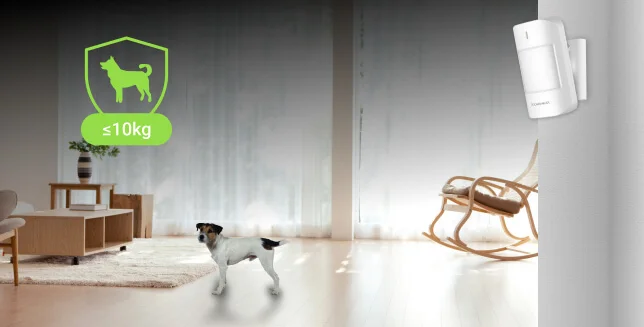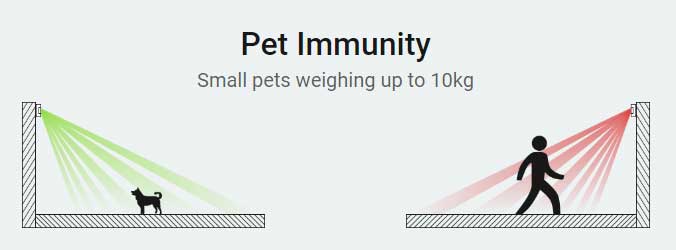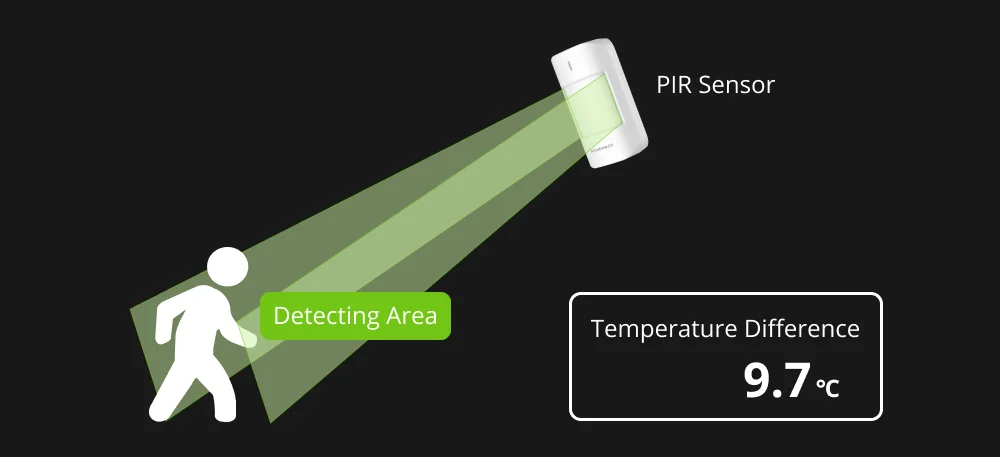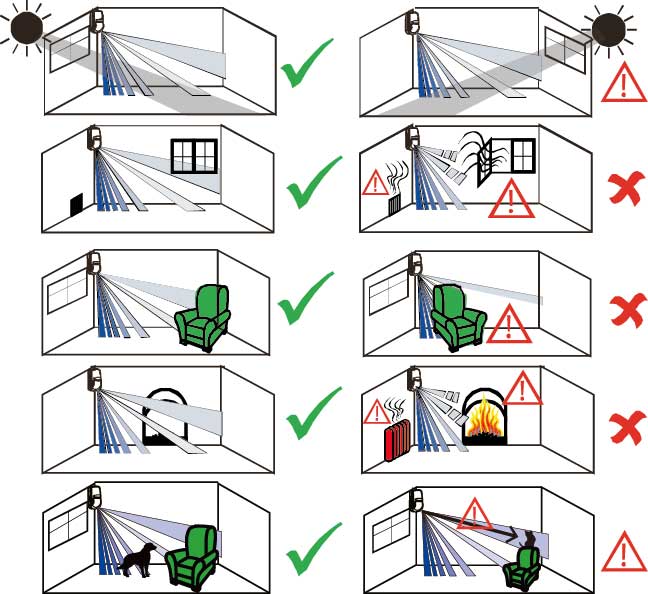Pet-friendly motion sensors are small in size, but huge in peace of mind!

Over the past three decades, pet ownership in the United States has increased dramatically, according to Forbes statistics. 66% of American households, or 86.9 million residences have pets, as of 2024. Pets provide invaluable companionship and emotional support to their owners.
However, as crime rates continue to grow in many areas, more homeowners are becoming concerned about the safety and security of their homes, which is driving up the demand for pet-friendly home security systems. Pet-friendly PIR motion sensor is an essential component of the home alarm systems.
What is a Pet-friendly PIR Motion Sensor?
PIR Motion sensors for home alarm systems are one of first line of detecting home intruders. These alarms trigger as soon as someone trespasses into your home.
In an ideal world, a PIR sensor only responds when it detects another person, specifically, an intruder. It shouldn’t react to changes in humidity, wind, rain, vibration, and even temperature unless another human being crosses its line of sight.
Unfortunately, standard PIR motion detector respond to non-human presence: they can’t tell between humans and pets. And this results in frequent false alarm. Excessive exposure to false alarms can result in alarm fatigue and alarm desensitization. These can result in longer response times to alarms. In worse cases, it might even cause homeowners to miss intruder alerts. In worse cases, a false alarm can cause local authorities to come, resulting in increased risk to firefighters and the general public.
A solution to this problem is having a pet-friendly Passive Infrared sensor. Pet-friendly PIR sensors are also called pet immunity motion detector that creates a detection area within its infrared lens that’s less sensitive to pets’ thermal change.

These intrusion detection alarm systems based on pet-friendly PIR sensors are more accurate compared to the standard alarm system. They’re designed to be able to tell between the movements of humans and potential intruders and your pets, even large dogs.
The exact specifications depend on the pet-friendly PIR alarm system. Pet-friendly PIR sensors can ignore movements that fall below certain thresholds. But in what way?
How Does A Pet-Friendly PIR Sensor Work?
Standard PIR sensors have three main components: a special-curved Fresnel lens, an IR sensor with a pyroelectric element, and a microprocessor. The Fresnel lens creates a designated detection area and focuses infrared (IR) radiation on the IR sensor. The IR sensor then converts infrared radiation into electrical signals, and the microprocessor converts them to digital data.
Read More: What is a PIR Sensor and What Does PIR Mean?
Traditional PIR sensors detect changes in IR radiation. This is why the sensor triggers whenever a person walks through a sensor’s field of view.
However, pet-friendly PIR sensors don’t solely rely on changes in heat signatures. They use optimize Fresnel lens and advanced software algorithms to analyze collected signals before deciding whether to raise an alarm or ignore it.
As most pets are small and mainly roam on the ground, they might not cause a significant enough change in body heat to trigger the alarm. If you mount the PIR sensor at a certain height range, it is less sensitive to movement closer to the ground (under 50 cm). But, this is susceptible to false alarms if you have larger pets, which can be frustrating and potentially dangerous.
Difference Between Pet-Friendly PIR Sensors and Universal PIR Sensors
Universal and pet-friendly PIR sensors have similarities, but they’re also different in many years. Universal PIR sensors are used everywhere, like enabling automated lighting when detect moving motion in homes. Manufacturers design pet-friendly PIR sensors with smaller animals, specifically, pets in mind.
The extra optimization added to pet-friendly PIR sensors makes them the better choice for pet owners. In particular, the pet-immunity function allows these sensors to distinguish between the movement of pets and their owners.
Here’s a breakdown of how these systems work in conjunction to secure your home while minimizing false alarms:
Optimized Fresnel Lens and Detection Zones
Imagine a magnifying glass focusing sunlight onto a single point. That’s kind of what a Fresnel lens does for PIR sensors, but with heat instead of light. This lens concentrates the infrared radiation onto the IR sensor, making it more sensitive to even small temperature changes.

Think of it like the difference between feeling a gentle breeze and a strong gust of wind – the more focused the IR radiation, the better the sensor can distinguish between a 10kg cat and a 20kg dog wandering by.
Pet-friendly PIR sensors take things a step further by dividing their field of view into multiple zones, each with a sensitivity level. Typically, the lower zones closer to the ground are less sensitive to temperature changes.
This way, the sensor can ignore your cat’s ninja-like climbing skills or your dog’s playful zoomies without setting off the alarm. This is how these pet-friendly PIR motion sensors can help trigger fewer to nonexistent false alarms.
Think of it like security checkpoints at an airport – some areas require more scrutiny than others.
Advanced Software Algorithms to Make Decisions
The final piece of the puzzle is the software. The IR sensor picks up infrared signals from the Fresnel lens and converts them into electrical signals. The software then analyzes these signals, looking for patterns specific to human movement.
Think of it like comparing a fingerprint – if the pattern doesn’t match a human’s thermal signature, the software ignores it. Like the Fresnel lenses, different manufacturers use different algorithms, which can affect how well the software distinguishes between pets and people.
By combining these technologies, pet-friendly PIR sensors offer a smarter, false alarm-averse alternative to home security. They significantly reduce the false triggering of your alarm systems caused by pets, giving you peace of mind and a more reliable security system.
Now you can enjoy the benefits of home security without worrying about your furry friend triggering an unwanted siren every time they walk by.
Key Consideration When Using Pet-Friendly PIR Sensors
After knowing how these innovative security devices utilize advanced technology to differentiate between human movement and the movement of smaller animals. These tips can help you get the most out of your pet-friendly PIR sensor and home security system:
Install PIR Sensors at Proper Height to Avoid False Alarms
Mounting the sensor at the recommended height ensures it can detect human movement while minimizing false alarms from your furry companions. For optimal results, Most pet-friendly PIR sensors recommend mounting between 2 and 2.2 meters (6.6 and 7.2 feet) high. This way, it’s more likely to ignore the movement of pets shorter than 50 centimeters. This minimizes false alarms triggered by pets walking around on the ground.

Most pet-friendly PIR motion sensors will be equipped with a user manual with such info on it.
However, active pets that like to climb up chairs and tables might still trigger a false alarm. This is why it’s recommended to place a pet-friendly PIR sensor up high while clearing the area of things like tablets and ladders that pets can use to climb.
Install PIR Sensors at Placement with Less Interference
Think strategically about where to install your sensor. Remember, PIR motion sensors use temperature changes to detect motion in the environment. They are still susceptible to false alarms when installed incorrectly or too much interfering factors.

Keep these things in mind for proper installation and optimal results:
- Direct exposure to sunlight can affect the sensor’s accuracy. Look for sensors with digital temperature compensation technology. This feature allows specific models of sensors to adjust and correct based on temperature fluctuations.
- Avoid mounting the sensor near heat sources like windows and air vents from your heating system. These are susceptible to sudden spikes in temperatures, especially at certain times of the day. If you’re not careful, installing PIR motion sensors near these areas can trigger an annoying false alarm.
- Consider rooms that are easily accessible like living rooms or hallways, but try to avoid areas with frequent pet traffic.
- Never place sensors near furniture like tables and sofas. Your pets could climb up the furniture and get closer to the sensor’s detection zone, which can result in a false alarm.
Securing Your Space Without Blind Spots
Pet-friendly PIR sensors also have a blind spot around them. The sensor can’t detect movement within this radius. Before installing a pet-immune motion sensor, consider your room layout and potential challenges. The right placement will ensure your PIR motion sensor keeps your family and pets safe and secure without leaving you frustrated and anxious from constant false alarms.

As a tip, you should imagine the PIR sensor as a security guard. You’ll want to station them in an area where they’ll have a clear view of the environment you want them to protect.
Here are some factors you should consider when mountain a PIR motion sensor:
- Mounting Location: Think about where you plan to install the sensor. Are there any limitations or ideal spots in the room?
- Mounting Options: Does the sensor offer different mounting options, like wall mounting or corner mounting, to fit your space?
- Room Layout and Size: Consider the shape and size of the room you want to secure. Will the sensor’s detection area provide sufficient coverage without any blind spots? The fewer blind spots, the better overall security.
What to Consider When Buying Pet-Friendly PIR Sensors
By filtering out pet movement, these PIR sensors significantly reduce false alarms. This gives you the peace of mind of knowing that you’re minimizing unnecessary dispatch of local authorities and emergency services.
The best part is that pet-friendly PIR sensors give you the benefit of enjoying your home without worrying if your furry companions will trigger another false alarm. So, how to buy PIR sensors? Are there any other considerateness?
Pay Attention to Pet Weight and Size
While pet-friendly PIR sensors are highly effective, it’s important to note that they may have limitations with larger pets like Great Danes or Saint Bernards. After all, pet-friendly PIR sensors use weight to judge the pet size.
Pet immunity features are usually designed for a specific weight range. This is because size of each kinds of pets is hard to estimated due to many varying factors. Weight is an effective to method to evaluate the pet-immune features. Some sensors can only go up as high as 10kg while others max out at 15kg, 20kg, 25kg, 35kg, and so on.
When choosing a pet-friendly PIR sensor, it’s always best to check the weight capacity specified by the PIR sensor manufacturer, and make sure that you buy one that fits the size range of your pets.
However, it’s important to consider if you have a heavier pet. It might think that your pet is larger than it is because of its weight. Choosing a sensor whose maximum allowable range accommodates your pet’s weight and size.
Here’s how you can find the perfect match for your pet:
- Knowing your pet’s weight is the first step. Grab a scale and weigh your companion. This is how you measure how much your furry friend weighs.
- Once you have your pet’s weight, choose a sensor with a pet immunity range that comfortably accommodates their size. This way, you can avoid choosing a pet-friendly sensor that triggers whenever it detects your pet’s movement.
Compatibility with Your Existing Security System
If you already have an existing security system, do your due diligence and ensure compatibility. Different systems have specific communication protocols and wiring requirements. It might be necessary to consult the company that installed your original alarm system or a local contractor for more information.
Also Read: Types of Burglar Alarm Systems for Houses, Which One Should You Choose?
Also Read: Types of Alarms in Apartments, How to Choose the Right One?
Additional False Alarm Reduction Features
False alarms are a common problem for motion detectors. Using a pet-friendly PIR sensor can help minimize such instances. However, other motion sensor alarms might come with additional features. This could include automatically adjustable sensitivity zones, remote configuration and control via an app, and protection from potential tampering, among others.
Budget
Pet-friendly PIR sensors are a great way to secure your home without the hassle of false alarms.
Here’s a breakdown of key factors to consider with your budget in mind:
- If you’re on a tight budget, a high-quality PIR sensor with basic pet immunity features can do wonders. These sensors typically ignore smaller pets like cats and some smaller dogs. These devices usually don’t come with monthly security fees as well. All that’s required is for you to spend on the device.
- If you have larger pets or they frequently move through the sensor’s detection zone (like hallways), investing in a more expensive dual-technology sensor might be a good choice. These combine PIR with another technology, like microwave detection, for added accuracy and reduced false alarms from larger animals.
- For a more complete security system, you can add more devices like windows and door sensors and a Home Security Hub. These systems can connect to a monitoring company or your own mobile phone that will help dispatch emergency services when something triggers the alarm. But, this will come with significantly higher upfront costs and monthly monitoring fees.
Final Thoughts
It’s not uncommon for homeowners to turn off their home’s security systems because of their pets. This fear of false alarms puts you and your family at risk for crime. PIR motion detectors are an integral part of your home’s security. You shouldn’t compromise your safety because of your pets.
Thankfully, pet-friendly PIR motion sensors use some clever technology to differentiate between human intruders and your beloved pet, and give you the confidence you need to secure your home without limiting your pet’s freedom.
Roombanker Wireless Security Alarm System combines ease of use with professional-grade features, offering effortless DIY installation and set up. It also integrates professional-grade features, including advanced detectors like pet-friendly PIR motion sensors, a dedicated security hub, and supports integration with Alarm Receiving Centres, etc, making it the go-to choice for a reliable wireless security alarm system, supporting intrusion alarm, fire & water leak alarm, panic alarm, etc., serving an array of small business and residential properties.
Our products are currently available for purchase across the United Kingdom and Europe. Roombanker is also open to partners who want to distribute our products in their countries.
